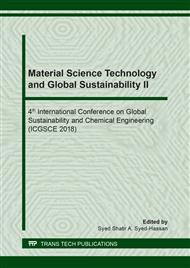[1]
T. Shen, S. Gnanakaran. The stability of cellulose: A perspective from the statistical mechanics of hydrogen bond networks. Biophys. J. 96 (2009), 100–101.
Google Scholar
[2]
J. Bian, F. Peng, X-P. Peng, P. Peng, F. Xu, R-C. Sun. Acetic acid enhanced purification of crude cellulose from sugarcane baggase: Structural and morphological characterization, Bioresources. 7 (2012) 4626–4639.
DOI: 10.15376/biores.7.4.4626-4639
Google Scholar
[3]
A. Demirbas, Heavy metal adsorption onto agro-based waste materials: A review. Journal of Hazardous Materials. 157 (2008) 220–229.
DOI: 10.1016/j.jhazmat.2008.01.024
Google Scholar
[4]
D. S. Malik, C. K. Jain, A. K. Yadav. Removal of heavy metals from emerging cellulosic low-cost adsorbents: a review. Appl. Water Sci. 7 (2016) 2113–2136.
DOI: 10.1007/s13201-016-0401-8
Google Scholar
[5]
S. Hokkanen, A. Bhatnagar, M. Sillanpää, A review on modification methods to cellulose-based adsorbents to improve adsorption capacity, Water Res. 91 (2016) 156–173.
DOI: 10.1016/j.watres.2016.01.008
Google Scholar
[6]
J. A. Avila Ramirez, E. Fortunati, J. M. Kenny, L. Torre, M. L. Foresti. Simple citric acid-catalyzed surface esterification of cellulose nanocrystals, Carbohydrate Polymers. 157 (2017) 1358 –1364.
DOI: 10.1016/j.carbpol.2016.11.008
Google Scholar
[7]
D.W. O'Connell, C. Birkinshaw, T. F. O'Dwyer. Heavy metal adsorbents prepared from the modification of cellulose: A review, Bioresource Technology. 99 (2008) 6709–6724.
DOI: 10.1016/j.biortech.2008.01.036
Google Scholar
[8]
D. Firmansyah, B. Rumhayati, Masruri. Modification of pineapple leaf cellulose with citric acid for Fe2+ adsorption, International Journal of Chem. Tech. Research, 10 (2017), 674-680.
Google Scholar
[9]
X. M. Li, Y. R. Tang, X. Cao, D. Lu, F. Luo, W. Shao. Preparation and evaluation of orange peel cellulose adsorbents for effective removal of cadmium zinc cobalt and nickel, Colloids and Surfaces A: Physicochemical Engineering Aspects. 317 (2008) 512-521.
DOI: 10.1016/j.colsurfa.2007.11.031
Google Scholar
[10]
C. Tejada, A. Herrera, and E. Ruiz. Kinetic and isotherms of biosorption of Hg (II) using citric acid treated residual materials, Ing. y Competividad. 18 (2016) 113 – 123.
DOI: 10.25100/iyc.v18i1.2182
Google Scholar
[11]
J. S. Yadav, M. Soni, A. Lashkari, Equilibrium and kinetic studies of zinc (II) ion adsorption from aqueous solution by modified soybean hulls. Int. Ref. J. Eng. Sci. 6 (2017) 30–35.
Google Scholar
[12]
J. D. McSweeny, R. M. Rowell, S.-H. Min. Effect of citric acid modification of aspen wood on sorption of copper ion. J. Nat. Fibers. 3 (2006) 35–41.
DOI: 10.1300/j395v03n01_05
Google Scholar
[13]
R. G. Raj, B. V. Kokta. Mechanical properties of surface-modified cellulose fiber—thermoplastic composites, in: R. M. Rowell, T. P. Schultz, R. Narayan (Eds.), Emerging Technologies for Materials and Chemicals from Biomass, American Chemical Society, Washington, 1992, p.76–87.
DOI: 10.1021/bk-1992-0476.ch006
Google Scholar
[14]
R. T. Morrison, R. N. Boyd, Organic Chemistry, sixth ed., Prentice-Hall, Inc., New Jersey, (1992).
Google Scholar
[15]
A. C. Khazraji, S. Robert. Self-Assembly and intermolecular forces when cellulose and water interact using molecular modelling, Journal of Nanomaterials. 12 (2013), 1-10.
DOI: 10.1155/2013/745979
Google Scholar
[16]
T. Egami, S. J. . Billinge, Underneath the Bragg Peaks, second ed., Pergamon, Oxford, (2012).
Google Scholar
[17]
T. Nguyen, H. Ngo, W. Guo, J. Zhang, S. Liang, Q. Yue, Q. Li, T. Nguyen. Applicability of agricultural waste and by-products for adsorptive removal of heavy metals from wastewater, Bioresource Technology. 148 (2013) 574–585.
DOI: 10.1016/j.biortech.2013.08.124
Google Scholar
[18]
K. J. Johnson, R. T. Cygan, J. B. Fein. Molecular simulations of metal adsorption to bacterial surfaces, Geochim. Cosmochim. Acta, 70 (2006) 5075–5088.
DOI: 10.1016/j.gca.2006.07.028
Google Scholar
[19]
C. Y. Kuo, C. H. Wu, M. J. Chen. Adsorption of lead ions from aqueous solutions by citric acid-modified celluloses, Desalin. Water Treat., 55 (2015) 1264–1270.
DOI: 10.1080/19443994.2014.926460
Google Scholar
[20]
K. Raghavan, M. R. Reddy, M. L. Berkowitz. A molecular dynamics study of the structure and dynamics of water between dilauroylphosphatidylethanolamine bilayers, Langmuir. 8 (1992) 233–240.
DOI: 10.1021/la00037a043
Google Scholar
[21]
E. Brini, C. J. Fennell, M. Fernandez-Serra, B. Hribar-Lee, M. Lukšič, K. A. Dill. How water's properties are encoded in its molecular structure and energies, Chem. Rev.117 (2017) 12385–12414.
DOI: 10.1021/acs.chemrev.7b00259
Google Scholar
[22]
B. O. D. William, C. B. David, E. M. Sylvia. Structural evidence for inter-residue hydrogen bonding observed for cellobiose in aqueous solution, PLOSONE. 7 (2012) 1-10.
Google Scholar


